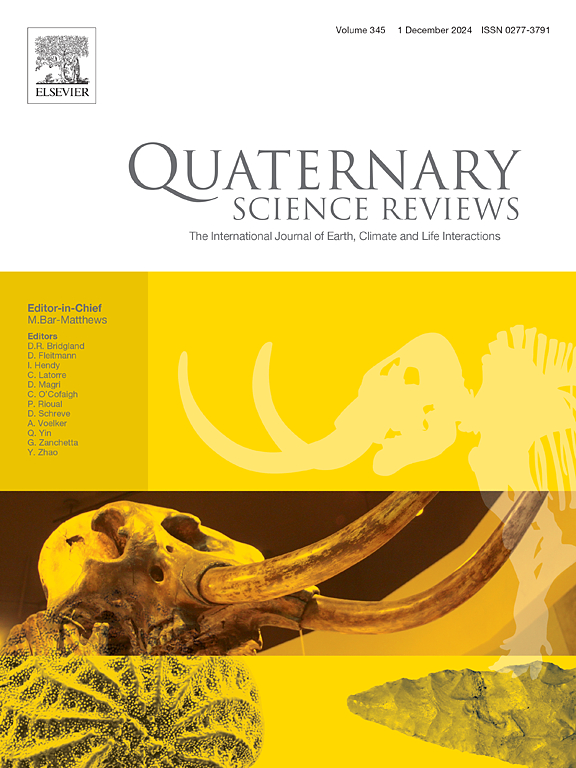在南美洲南部人类殖民期间,阿根廷大陆架的潜在用途。古地理模型和考古期望
IF 3.2
1区 地球科学
Q1 GEOGRAPHY, PHYSICAL
引用次数: 0
摘要
对南美洲南端人类殖民的分析包括探索多种环境和生态变化,以及由于晚更新世冰原退缩和海侵造成的重要地理变化。在本文中,我们通过以下程序研究了15,000至10,000 calyr BP之间人类在巴塔哥尼亚南部(平行47°以南)的殖民过程。首先,我们使用地理信息系统(GIS)和数字高程模型(DEM)进行了详细的水深分析,并生成了一系列古地理模型。其次,基于古地理重建和现有考古证据,我们使用gis生成的最小成本路径分析模拟模型,特别强调海平面变化和物理空间条件,研究了该地区的假设扩散路径。研究结果表明,阿根廷大陆架(ACS)可能在巴塔哥尼亚南部狩猎采集者早期迁徙过程中发挥了重要作用,为人类迁徙提供了较低的障碍或成本,为巴塔哥尼亚其他地区提供了没有类似生态位的可能生态位,并为人类居住提供了有利的环境条件。这一预期也被整合到现有的讨论框架中,即在更新世-全新世过渡期间,该地区高原地区记录的人类职业在地理上的不连续分布,这可能与大陆架地区更密集的人口节点相互作用。本文章由计算机程序翻译,如有差异,请以英文原文为准。
The potential use of the Argentine Continental Shelf during the human colonization of southern South America. Paleogeographic models and archaeological expectations
The analysis of human colonization of the southern tip of South America involves exploring diverse environmental and ecological changes, in addition to the important geographic transformations due to the retreat of ice fields and marine transgression during the late Pleistocene. In this paper, we examine the process of human colonization in southern Patagonia (south of parallel 47°) between 15,000 and 10,000 cal yr BP by means of the following procedure. First, we performed a detailed bathymetric analysis and generated a series of palaeogeographic models using a Geographic Information System (GIS) and Digital Elevation Models (DEM). Secondly, based on the palaeogeographic reconstructions and available archaeological evidence, we examined hypothetical dispersal pathways in the region using GIS-generated Least Cost Path Analysis simulation models with special emphasis on sea level changes and physical spatial conditions. The results suggest that the Argentine Continental Shelf (ACS) may have played an important role in the early dispersal of hunter-gatherers in southern Patagonia, either by presenting lower impediments or costs for human mobility, possible ecological niches without analogues in other sectors of Patagonia, and favorable environmental conditions for human habitation. This expectation is also integrated within an existing framework of discussion about a geographically discontinuous distribution of human occupations recorded in the plateau sector of the region during the Pleistocene-Holocene transition, which possibly interacted with denser population nodes in the continental shelf sector.
求助全文
通过发布文献求助,成功后即可免费获取论文全文。
去求助
来源期刊

Quaternary Science Reviews
地学-地球科学综合
CiteScore
7.50
自引率
15.00%
发文量
388
审稿时长
3 months
期刊介绍:
Quaternary Science Reviews caters for all aspects of Quaternary science, and includes, for example, geology, geomorphology, geography, archaeology, soil science, palaeobotany, palaeontology, palaeoclimatology and the full range of applicable dating methods. The dividing line between what constitutes the review paper and one which contains new original data is not easy to establish, so QSR also publishes papers with new data especially if these perform a review function. All the Quaternary sciences are changing rapidly and subject to re-evaluation as the pace of discovery quickens; thus the diverse but comprehensive role of Quaternary Science Reviews keeps readers abreast of the wider issues relating to new developments in the field.
 求助内容:
求助内容: 应助结果提醒方式:
应助结果提醒方式:


